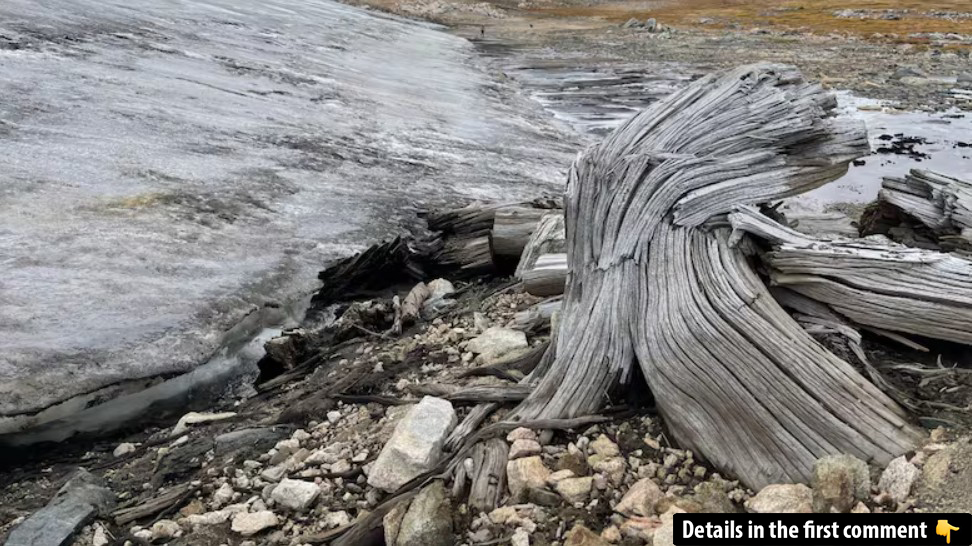The melting of ice in the Rocky Mountains has led to the dramatic resurfacing of an ancient forest, offering a rare glimpse into Earth’s past. Discovered by a team of scientists from Montana State University and the U.S. Geological Survey, this forest, dating back nearly 6,000 years, reveals not only the grandeur of nature’s resilience but also a warning sign of how quickly the environment is shifting due to climate change. This unprecedented discovery near the Beartooth Plateau in Wyoming opens up new questions about our planet’s future, as well as how swiftly nature is responding to global warming.
The Discovery
Nestled at an elevation of 3,000 meters, far above today’s tree line, the discovery of an ancient whitebark pine forest was an unexpected and thrilling moment for researchers. The forest had remained hidden under an ice patch for thousands of years, only to emerge as the ice melted due to rising temperatures. This ancient forest, which once thrived in a much cooler climate, was uncovered during an archaeological survey of the Beartooth Plateau, an area known for its dramatic landscapes and unique ecosystems. The research team was initially surprised to find that a forest of trees was emerging from the melting ice—a phenomenon that highlights just how dramatically the environment is changing.
This discovery was not only significant for its archaeological value but also for what it could tell us about the rapid shifts happening in the Earth’s climate. The ancient trees that were uncovered have been carbon-dated to between 5,950 and 5,440 years ago. What is particularly fascinating is the location: 180 meters above the current tree line, revealing that ancient forests once grew far higher in the mountains, at elevations that are now too harsh for such life forms to survive.

Video
Watch this video to see how melting ice is uncovering hidden Viking artefacts, as reported by BBC News.
The Ancient Forest
The forest uncovered by the melting ice represents a snapshot of a very different world—one where the climate was cooler and conducive to the growth of tall trees. The trees, primarily whitebark pines, were not the scrappy, stunted trees typically found at higher altitudes today, but instead were tall and thriving. This well-developed forest offers insight into what the region was like thousands of years ago, and how climates have changed over time.
Using cutting-edge carbon dating and tree ring analysis, scientists were able to pinpoint the exact age of the trees and learn about the climatic conditions in which they grew. Cathy Whitlock, a lead researcher from Montana State University, expressed both excitement and sadness at the discovery. While it offered a fascinating look into the past, it was also a stark reminder of the impacts of climate change. The ancient forest’s burial under ice was due to a gradual cooling of the climate thousands of years ago, which allowed the ice to cover the trees, preserving them. However, in today’s warming climate, it’s the melting ice that is revealing these long-hidden forests, offering both a glimpse into the past and a warning for the future.

The Role of Climate Change
This discovery serves as a potent reminder of the speed with which climate change is altering the planet. The trees were buried under ice as the climate cooled around 5,000 years ago, and as the ice began to melt due to warming temperatures, the forest has resurfaced. But this event also raises concerns about what the future holds for similar high-altitude forests.
Whitlock and her team are investigating the effects of climate change by studying the chemistry of the ice patch to better understand how the climate has changed over time. The rapidity with which this change has occurred in recent decades—comparable to what once took thousands of years—underscores the urgency of addressing climate change. The accelerated warming has led to environmental changes that are not only visible in forests but also affect water systems, wildlife, and ecosystems in a dramatic way.
The melting of the ice patch and the resurfacing of the ancient forest also offers a lesson in the fragility of our ecosystems. What took millennia to form is being undone in a matter of decades, making the study of such regions even more crucial. The forest may one day return as temperatures continue to rise, with the treeline moving higher up the mountains, but in doing so, it could disrupt local ecosystems that depend on the current water flow patterns and precipitation levels.
What’s Next: Further Research
Despite the excitement surrounding this discovery, researchers know that much more work remains. Whitlock’s team is not only studying the trees themselves but is also investigating the ice patch’s chemical composition to uncover more about how the climate has evolved. As Whitlock said, there is still much that we don’t understand about high-elevation forests and how they are likely to respond to future climate shifts.
In addition to the direct impact of climate change on the environment, there is the broader context of how such discoveries can inform our understanding of ecosystems and the ways in which human activities are influencing them. The rapid changes to the environment have profound implications, not just for plant life, but for wildlife, water resources, and agriculture, making this research even more important for understanding our world’s future.
Implications for the Future
The potential loss of snowpack and its consequences are already becoming clear in regions like the Rocky Mountains. As temperatures rise, the balance between snowfall and rainfall is shifting, with more precipitation falling as rain rather than snow. This can lead to a faster runoff and a reduction in the amount of water stored in snowpack. The loss of this natural water reservoir, which feeds rivers and streams throughout the year, could have serious consequences for agriculture, water supply, and wildlife.
Moreover, as the treeline shifts higher, the ecosystems that depend on these high-elevation environments will likely be displaced, further stressing the delicate balance of local ecosystems. This discovery underscores the need to consider the broader environmental implications of climate change, particularly in the most vulnerable regions, such as the high-altitude forests that are sensitive to even slight shifts in temperature.
Video
Tune into this video to uncover the fascinating secrets hidden in melting glaciers.
Conclusion: Lessons for the Future
The ancient forest uncovered in the Rocky Mountains serves as a powerful testament to the fragility and resilience of nature. While it is exciting to uncover ancient forests that have been hidden under ice for thousands of years, it also underscores the rapid pace of climate change that is reshaping ecosystems worldwide. The research conducted by Whitlock and her team highlights the critical need for further study of high-elevation forests, as well as the broader implications of warming temperatures on the environment.
Ultimately, this discovery reminds us of the urgent need to take action against climate change and protect our natural resources. As temperatures continue to rise, it is crucial that we understand how our planet’s ecosystems are changing, and what we can do to mitigate the negative impacts of these changes. By paying attention to these signs and studying the past, we can better prepare for the future and ensure that the natural world is preserved for generations to come.



